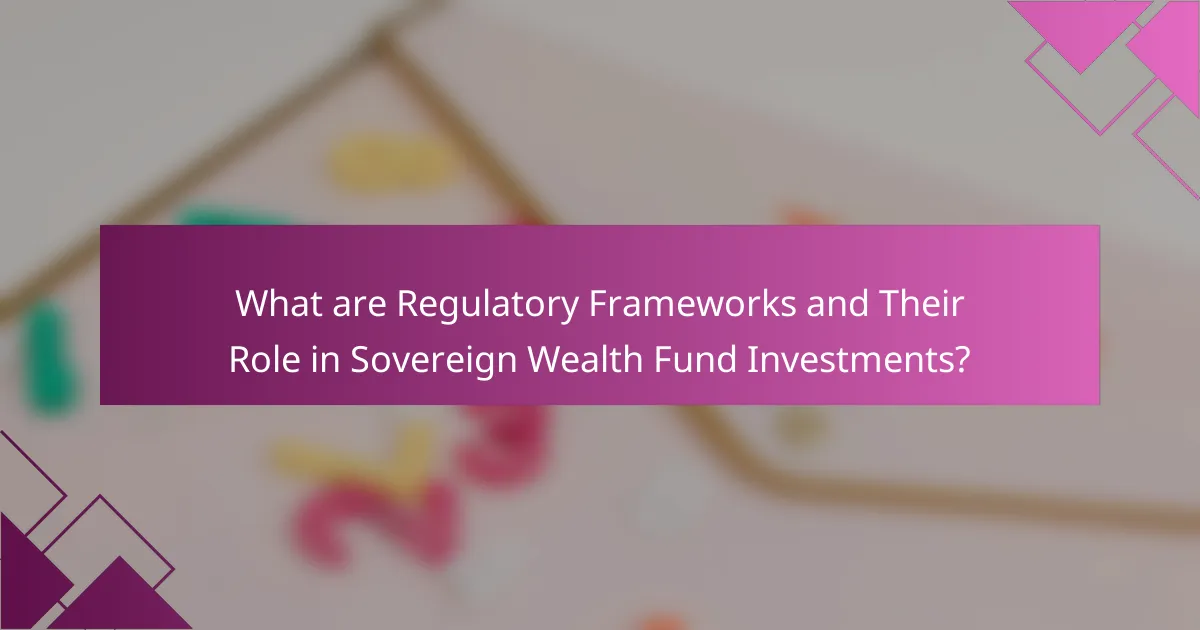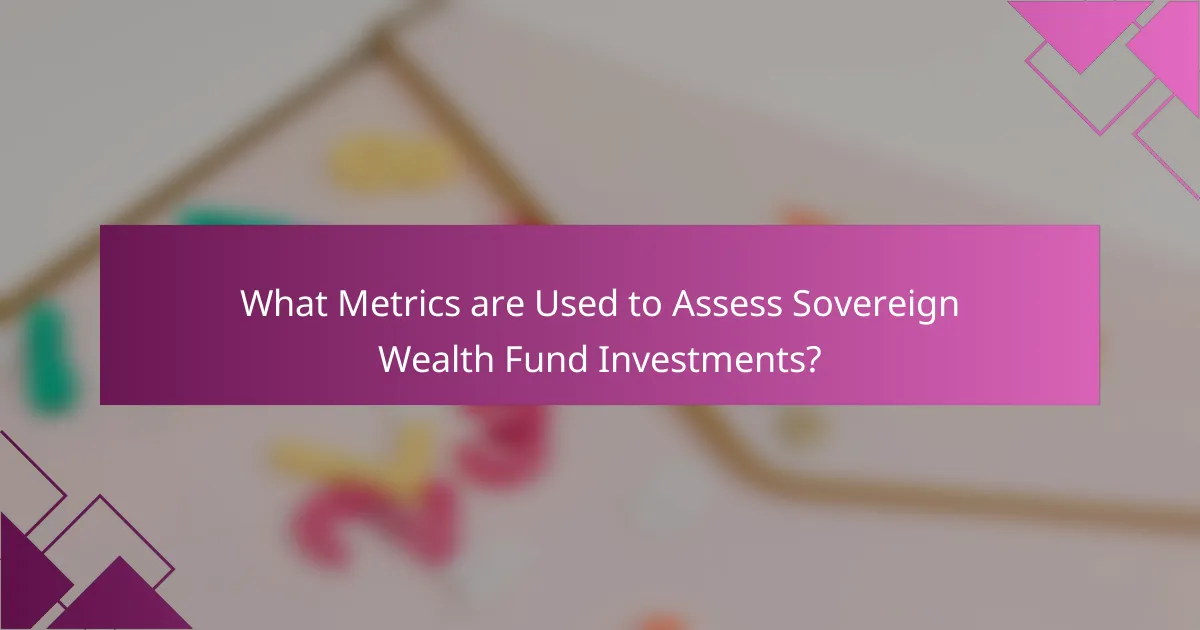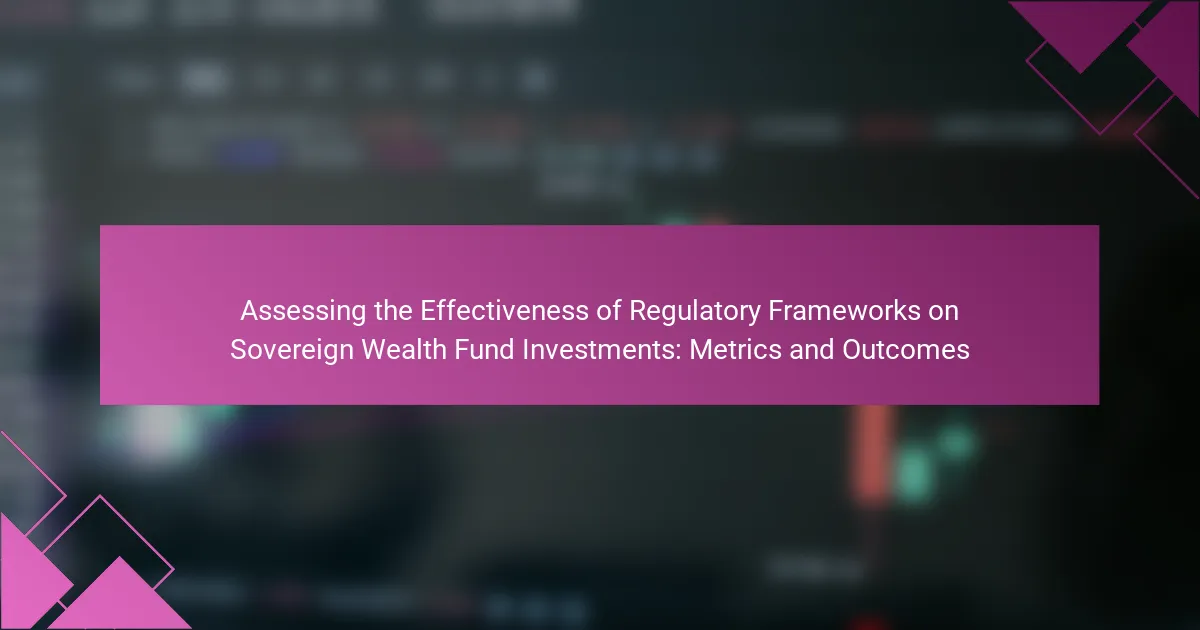
What are Regulatory Frameworks and Their Role in Sovereign Wealth Fund Investments?
Regulatory frameworks are structured guidelines that govern the operations of sovereign wealth funds. They establish rules for investment strategies, risk management, and transparency. These frameworks ensure that funds operate within legal and ethical boundaries. They also promote accountability to stakeholders and the public. Effective regulatory frameworks can enhance investor confidence. They help maintain stability in financial markets. Countries with robust regulations often see more significant foreign investments. For instance, Norway’s Government Pension Fund Global follows strict ethical guidelines, contributing to its reputation and success.
How do regulatory frameworks influence investment decisions of sovereign wealth funds?
Regulatory frameworks significantly influence the investment decisions of sovereign wealth funds. They establish the rules and guidelines that govern investment activities. These frameworks can dictate asset allocation, risk management, and compliance requirements. For instance, stricter regulations may limit investments in certain sectors or regions. Conversely, favorable regulations can encourage diversification and higher-risk investments.
The legal environment also impacts transparency and accountability. Sovereign wealth funds must adhere to reporting standards set by regulatory bodies. This ensures that their investment practices are scrutinized and aligned with national interests. Research indicates that countries with robust regulatory frameworks tend to attract more foreign investments. A study by the International Monetary Fund highlights that well-defined regulations enhance investor confidence.
Overall, the influence of regulatory frameworks on sovereign wealth funds is profound, shaping their strategies and outcomes in the global investment landscape.
What are the key components of effective regulatory frameworks?
Key components of effective regulatory frameworks include clarity, transparency, accountability, flexibility, and stakeholder engagement. Clarity ensures that regulations are easily understood and implemented. Transparency involves open communication of rules and processes, fostering trust among stakeholders. Accountability holds regulators and entities responsible for their actions, ensuring compliance. Flexibility allows frameworks to adapt to changing circumstances and emerging challenges. Stakeholder engagement involves collaboration with affected parties, enhancing the relevance and effectiveness of regulations. These components collectively contribute to a regulatory environment that supports sound governance and effective oversight in sovereign wealth fund investments.
How do regulations vary across different countries for sovereign wealth funds?
Regulations for sovereign wealth funds (SWFs) vary significantly across different countries. Each nation establishes its own legal framework governing SWFs. For instance, Norway’s Government Pension Fund Global operates under strict transparency and ethical guidelines. In contrast, some countries like China have less transparency and more government control over their SWFs. Additionally, countries such as Singapore emphasize a dual mandate focusing on returns and national interests. According to the International Working Group of Sovereign Wealth Funds, regulatory frameworks often reflect national priorities and economic conditions. This leads to diverse approaches in governance, reporting, and investment strategies among SWFs worldwide.
Why is assessing the effectiveness of these frameworks important?
Assessing the effectiveness of regulatory frameworks on sovereign wealth fund investments is crucial for ensuring optimal investment outcomes. Effective frameworks provide guidelines that help manage risks associated with investments. They also enhance transparency and accountability in fund operations. Furthermore, these frameworks can influence investor confidence and market stability. Research indicates that well-structured regulations lead to better financial performance. A study by the International Monetary Fund highlights that effective governance significantly impacts the returns of sovereign wealth funds. Therefore, continuous assessment allows for necessary adjustments to improve performance and adapt to changing market conditions.
What metrics are commonly used to evaluate the effectiveness of regulatory frameworks?
Common metrics used to evaluate the effectiveness of regulatory frameworks include compliance rates, enforcement actions, and stakeholder feedback. Compliance rates measure how well entities adhere to regulations. High compliance rates indicate effective regulations. Enforcement actions track the number and severity of penalties imposed. Frequent enforcement actions suggest that regulations are actively upheld. Stakeholder feedback provides insights into the perceived effectiveness of regulations. Positive feedback from stakeholders often reflects well-implemented frameworks. Additional metrics may include economic impact assessments and risk management outcomes. These metrics help ensure that regulatory frameworks meet their intended goals.
How do outcomes of investments reflect the effectiveness of these frameworks?
Outcomes of investments indicate the effectiveness of regulatory frameworks by demonstrating financial performance and risk management. Positive returns on investments suggest that the frameworks facilitate sound decision-making. For example, a sovereign wealth fund achieving a return of 8% annually shows effective governance and adherence to investment guidelines. Conversely, poor investment outcomes, such as a loss of 5%, may indicate flaws in the regulatory structure. Studies reveal that funds operating under robust frameworks outperform those with weaker regulations. This correlation highlights the importance of regulatory frameworks in guiding investment strategies. Thus, investment outcomes serve as a measurable reflection of the frameworks’ effectiveness.

What Metrics are Used to Assess Sovereign Wealth Fund Investments?
Metrics used to assess sovereign wealth fund investments include return on investment (ROI), risk-adjusted returns, and liquidity ratios. Return on investment measures the profitability of the fund relative to its costs. Risk-adjusted returns evaluate performance based on the level of risk taken. Liquidity ratios assess the fund’s ability to meet short-term obligations. Additionally, benchmarks against market indices provide comparative performance insights. These metrics help in understanding the effectiveness and efficiency of sovereign wealth fund investments.
How do quantitative metrics impact the assessment of investments?
Quantitative metrics significantly influence the assessment of investments by providing measurable data for analysis. These metrics include financial ratios, return on investment (ROI), and performance benchmarks. They enable investors to evaluate the profitability and risk associated with various investment options. For instance, a higher ROI indicates a more favorable investment outcome. Additionally, metrics like volatility and Sharpe ratio help assess the risk-adjusted returns of investments. Research shows that investors who utilize quantitative metrics make more informed decisions. A study by the CFA Institute highlights that data-driven analysis leads to improved investment performance. Thus, quantitative metrics are essential for effective investment assessment.
What are some examples of quantitative metrics used in this context?
Examples of quantitative metrics used in assessing regulatory frameworks on sovereign wealth fund investments include return on investment (ROI), which measures the profitability of investments. Another metric is the Sharpe ratio, which evaluates risk-adjusted returns. Additionally, asset allocation percentages provide insights into investment diversification. Tracking annualized performance against benchmarks is also common. These metrics help in evaluating the effectiveness of regulatory policies. They provide concrete data for analysis and decision-making.
How do qualitative assessments complement quantitative metrics?
Qualitative assessments enhance quantitative metrics by providing context and depth to numerical data. Quantitative metrics offer measurable outcomes, such as investment returns or asset allocations. However, they often lack insight into the underlying reasons behind those numbers. Qualitative assessments capture subjective factors, such as stakeholder perceptions or regulatory challenges. This combination allows for a more comprehensive understanding of investment effectiveness. For instance, qualitative insights can reveal how regulatory frameworks impact decision-making processes. Together, they enable better-informed strategies for sovereign wealth fund investments.
What role do benchmarks play in evaluating sovereign wealth fund performance?
Benchmarks serve as critical tools for evaluating sovereign wealth fund performance. They provide a standard against which the fund’s returns can be measured. This comparison helps in assessing whether the fund is achieving its investment objectives. Benchmarks can be based on market indices or peer group performance. Using benchmarks allows for a clearer understanding of risk-adjusted returns. It also aids in identifying areas of underperformance. According to the International Forum of Sovereign Wealth Funds, effective benchmarking enhances transparency and accountability in fund management. Overall, benchmarks are essential for informed decision-making and strategic adjustments in sovereign wealth fund operations.
How are benchmarks selected for sovereign wealth funds?
Benchmarks for sovereign wealth funds are selected based on their investment objectives and risk profiles. These benchmarks typically reflect the asset allocation strategy of the fund. They may include a mix of indices that represent various asset classes. Factors such as liquidity, market capitalization, and historical performance are considered during selection. Additionally, regulatory guidelines and best practices influence benchmark choice. Sovereign wealth funds often use custom benchmarks tailored to their unique investment strategies. This approach ensures alignment with long-term goals and risk tolerance. The effectiveness of these benchmarks is regularly assessed to ensure they remain relevant and effective.
What are the challenges in establishing effective benchmarks?
Establishing effective benchmarks faces several challenges. One major challenge is the lack of standardized metrics across different sectors. This inconsistency makes comparisons difficult. Additionally, data availability can be limited, hindering the establishment of reliable benchmarks. Variability in investment strategies also complicates the benchmarking process. Different sovereign wealth funds may have unique objectives and risk profiles. Furthermore, external economic factors can impact performance metrics. These factors can lead to fluctuating results that do not accurately reflect true performance. Lastly, the dynamic nature of markets requires benchmarks to be regularly updated. This ongoing need for adjustment can strain resources and complicate the benchmarking process.

What Outcomes Can Be Expected from Effective Regulatory Frameworks?
Effective regulatory frameworks can lead to improved governance and accountability. They establish clear rules that guide the behavior of sovereign wealth funds. This clarity reduces the risk of mismanagement and corruption. Enhanced transparency is another outcome, allowing stakeholders to monitor fund activities. Increased investor confidence often follows, as regulations reassure stakeholders about the integrity of investments. Furthermore, effective frameworks can promote sustainable investment practices. They encourage funds to consider environmental, social, and governance factors. Research indicates that well-regulated funds tend to perform better over the long term. A study by the International Monetary Fund shows that countries with robust regulatory frameworks experience more stable economic growth.
How do successful regulatory frameworks enhance investment performance?
Successful regulatory frameworks enhance investment performance by providing clear guidelines and stability. These frameworks reduce uncertainty for investors. They establish a predictable legal environment that fosters trust. Trust encourages both domestic and foreign investments. For instance, research shows that countries with strong regulatory frameworks attract 30% more foreign direct investment. Additionally, effective regulations promote transparency and accountability. This leads to better governance in investment processes. Improved governance can result in higher returns on investments. Overall, successful regulatory frameworks create conditions conducive to sustained investment growth.
What are some real-world examples of positive outcomes from effective regulations?
Effective regulations have led to significant positive outcomes in various sectors. For instance, the Dodd-Frank Act in the United States improved financial stability. It introduced measures that reduced systemic risk in the banking sector. Post-implementation, bank failures decreased significantly, showcasing enhanced oversight.
Another example is the Clean Air Act, which has reduced air pollution in the U.S. Since its enactment, emissions of key pollutants dropped by over 70%. This led to improved public health outcomes and reduced healthcare costs.
In the realm of food safety, the Food Safety Modernization Act has strengthened the U.S. food supply chain. It has resulted in a measurable decline in foodborne illnesses. Statistics show that foodborne illness outbreaks have decreased by nearly 20% since its implementation.
These examples demonstrate how effective regulations can foster stability, enhance public health, and improve safety in various industries.
How do these outcomes impact the broader economy?
The outcomes of regulatory frameworks on sovereign wealth fund investments significantly impact the broader economy. Effective regulations can enhance investment stability and attract foreign capital. This influx of capital can stimulate economic growth and job creation. For example, sovereign wealth funds often invest in infrastructure projects that boost productivity. Increased productivity can lead to higher GDP growth rates. Additionally, well-regulated funds can mitigate financial risks, promoting overall market confidence. Enhanced market confidence can result in increased consumer spending and investment. These dynamics collectively contribute to a more robust and resilient economy.
What challenges do sovereign wealth funds face in regulatory compliance?
Sovereign wealth funds face several challenges in regulatory compliance. These challenges include varying regulatory environments across jurisdictions. Different countries have distinct laws governing investment practices. This can create complications for funds operating internationally. Additionally, transparency requirements can differ significantly. Some jurisdictions mandate extensive disclosure, while others have minimal requirements. Compliance costs can also be high, impacting operational efficiency. Furthermore, the evolving nature of regulations poses a constant challenge. Funds must stay updated on changes to avoid penalties. Lastly, political risks can influence regulatory compliance, affecting investment strategies.
How can sovereign wealth funds navigate complex regulatory environments?
Sovereign wealth funds can navigate complex regulatory environments by employing comprehensive compliance strategies. These strategies involve understanding local laws and regulations in each jurisdiction. They often engage legal experts to interpret regulatory frameworks effectively. Additionally, sovereign wealth funds can establish strong relationships with regulatory bodies. This fosters open communication and ensures alignment with compliance requirements. They also utilize technology for monitoring regulatory changes and managing compliance risks. Regular training for staff on regulatory updates is crucial for maintaining adherence. By adopting these practices, sovereign wealth funds can mitigate risks associated with regulatory non-compliance.
What best practices can be adopted for effective compliance?
Effective compliance can be achieved through several best practices. First, organizations should establish clear compliance policies. These policies must be communicated to all employees. Regular training sessions enhance understanding and adherence to these policies. Conducting risk assessments helps identify compliance gaps. Implementing monitoring systems ensures ongoing compliance oversight. Additionally, maintaining open channels for reporting violations fosters a culture of accountability. Regular audits evaluate the effectiveness of compliance programs. These practices collectively improve compliance and mitigate risks associated with non-compliance.
What are the best practices for assessing the effectiveness of regulatory frameworks?
Best practices for assessing the effectiveness of regulatory frameworks include establishing clear objectives, measuring outcomes against these objectives, and engaging stakeholders. Clear objectives provide a benchmark for evaluation. Measuring outcomes quantitatively and qualitatively offers insights into effectiveness. Engaging stakeholders ensures diverse perspectives and enhances accountability. Regular reviews and updates to the frameworks are essential for adapting to changing circumstances. Utilizing data analytics can improve assessment accuracy. Benchmarking against international standards can provide context for evaluation. These practices ensure a comprehensive understanding of regulatory impacts.
How can continuous improvement be integrated into regulatory assessments?
Continuous improvement can be integrated into regulatory assessments by adopting a systematic approach to evaluate and enhance regulatory processes. This involves regularly collecting data on regulatory outcomes and stakeholder feedback. Utilizing performance metrics helps identify areas needing improvement. Implementing iterative review cycles allows for adjustments based on findings. Engaging stakeholders in the assessment process fosters collaboration and transparency. Benchmarking against best practices in similar sectors can guide enhancements. Documenting changes and their impacts ensures accountability and continuous learning. This approach aligns with the principles of adaptive regulation, which emphasizes responsiveness to evolving contexts and needs.
What tools and resources are available for effective assessment?
Quantitative metrics and qualitative analysis tools are available for effective assessment. Quantitative metrics include financial ratios, performance benchmarks, and risk assessments. These metrics provide measurable data on investment returns and risks associated with sovereign wealth funds. Qualitative analysis tools encompass stakeholder interviews, case studies, and policy reviews. These tools help to understand the context and impact of regulatory frameworks. Resources such as industry reports, academic journals, and government publications offer valuable insights. Specific examples include the International Monetary Fund’s reports on sovereign wealth funds. These resources provide empirical data and best practices for assessment.
The main entity of this article is regulatory frameworks governing sovereign wealth fund investments. The article provides a detailed analysis of how these frameworks influence investment strategies, risk management, and transparency within sovereign wealth funds. It outlines key components of effective regulatory frameworks, variations across different countries, and the importance of assessing their effectiveness through various metrics. Additionally, it discusses the impact of these frameworks on investment outcomes and the broader economy, while highlighting best practices for compliance and continuous improvement.
